Your experience at the Theatre
Bar and refreshment service
Before the performances and during intermissions two bars are open to the public on the second level of the foyer: you can enjoy excellent food preparations for a snack, drinks and espresso coffee.
You can also dine during the intermission, in a special area: in this case, before the performance, purchase you “Opera Buffet”.
Cloakroom
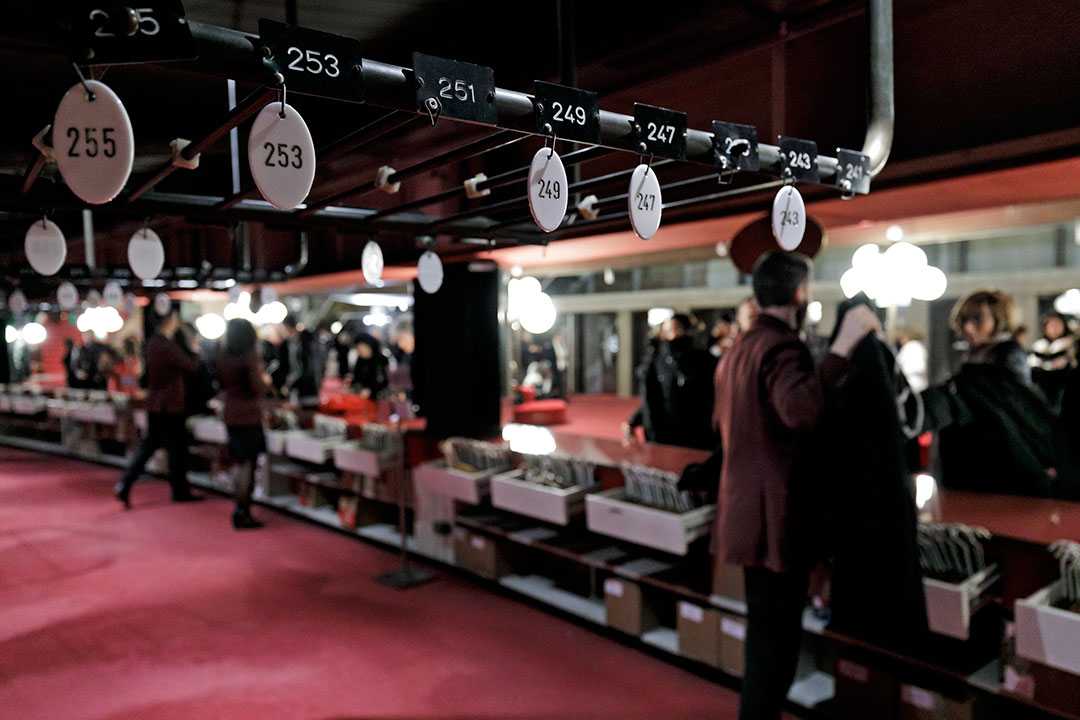 When you go to see a show you never know what to do with your jacket, your coat, your bag, and sometimes, your umbrella. Especially when it’s time to applaud! Fortunately, for both the performances in the main hall and those at the Piccolo Regio, a free cloakroom service is available.
When you go to see a show you never know what to do with your jacket, your coat, your bag, and sometimes, your umbrella. Especially when it’s time to applaud! Fortunately, for both the performances in the main hall and those at the Piccolo Regio, a free cloakroom service is available.
Publications
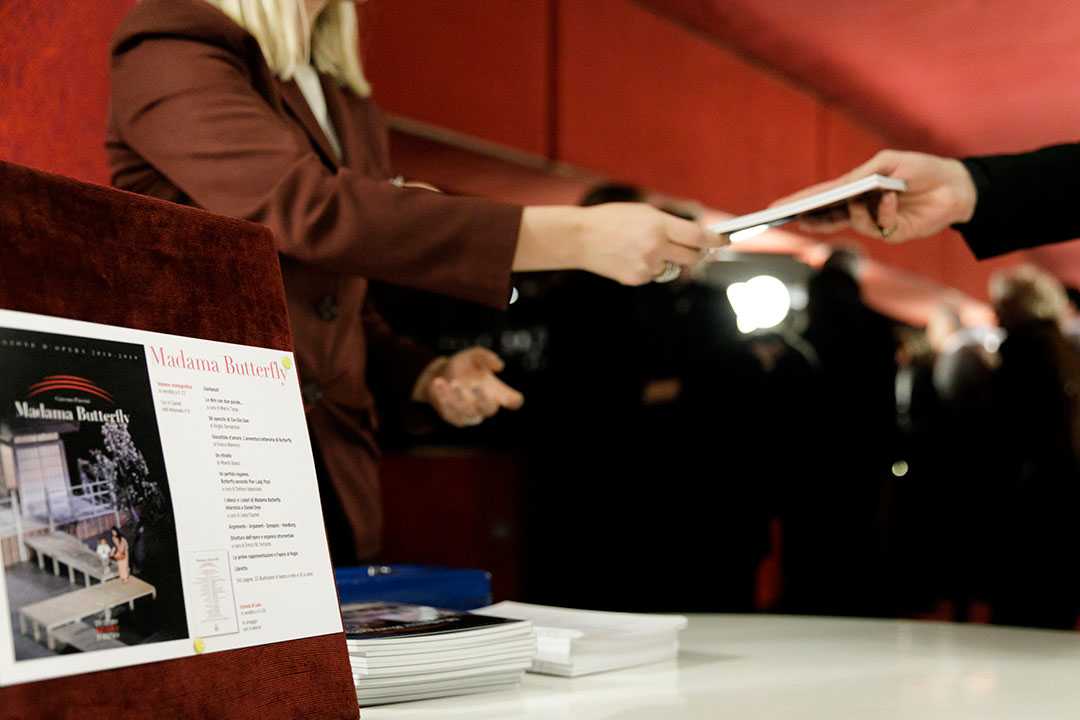 To know everything about the show you’re about to watch, pick up a monograph volume: here you’ll find presentation texts, interviews, detailed synopses and the complete libretto of the opera accompanied by numerous illustrations. You’ll receive a free copy of the leaflet with all the names of the interpreters for that show (also for sale separately). They will serve as mementos of an unforgettable evening.
To know everything about the show you’re about to watch, pick up a monograph volume: here you’ll find presentation texts, interviews, detailed synopses and the complete libretto of the opera accompanied by numerous illustrations. You’ll receive a free copy of the leaflet with all the names of the interpreters for that show (also for sale separately). They will serve as mementos of an unforgettable evening.
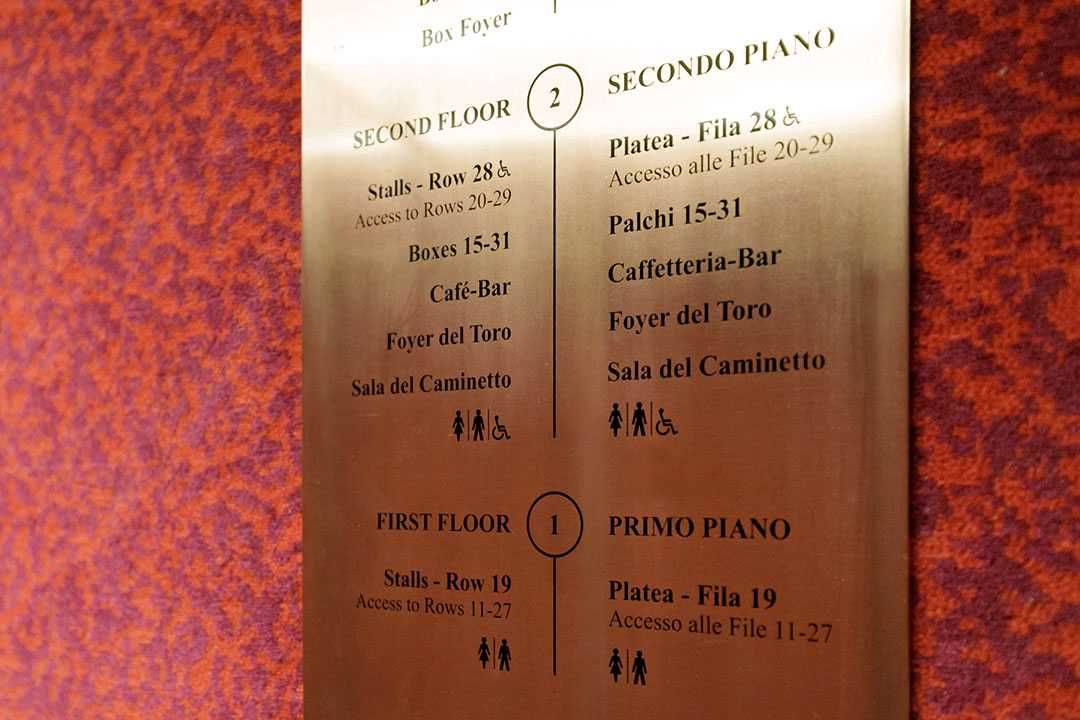
First time at the opera?
Contrary to what people often think, opera is meant for everybody: office workers, professionals, pensioners, students and teachers… The audience is only one, but it comes from all over, driven by the curiosity for a world where you speak, dream, love (and die…), always singing!
How should I dress?
Nobody will prevent you from dressing up for the opera, but the era when tails or a long dress were the rule is long over. Jeans, a top and trainers are welcome, just like a tuxedo and sequins… What’s important is that you feel at ease with yourself: therefore, feel free.
What time should I arrive?
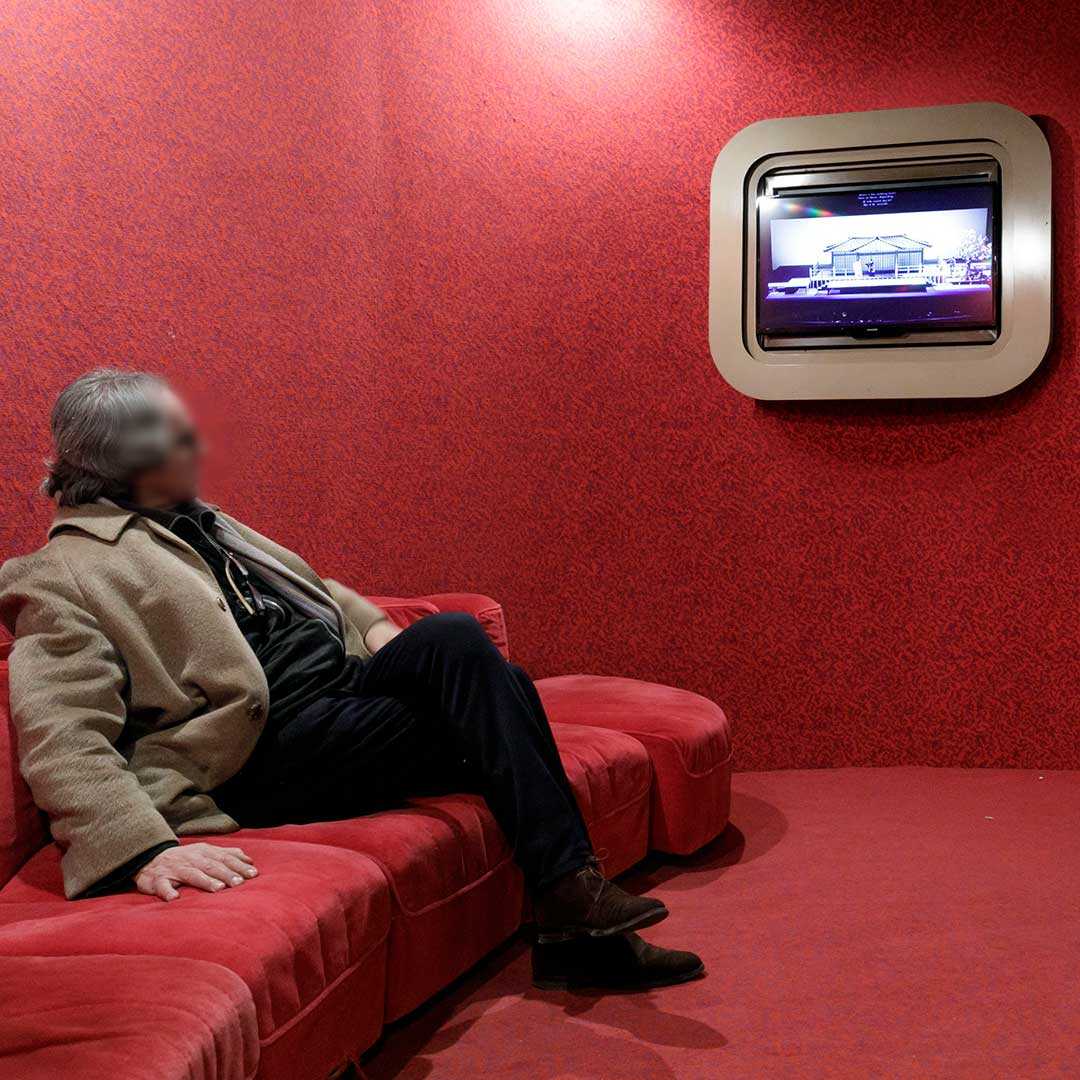 On time, obviously. Performances begin exactly at the time indicated on your ticket. We suggest arriving half an hour before the start (the Theatre opens 45 minutes before): this is the best way to avoid arriving stressed and overheated, in short, not in the best conditions to enjoy the show. Take your time, also because once the show begins you can enter the hall only during the intermissions and, even if there are areas with televisions in the foyer where you can see the show, it would be a real shame not to be able to watch it live!
On time, obviously. Performances begin exactly at the time indicated on your ticket. We suggest arriving half an hour before the start (the Theatre opens 45 minutes before): this is the best way to avoid arriving stressed and overheated, in short, not in the best conditions to enjoy the show. Take your time, also because once the show begins you can enter the hall only during the intermissions and, even if there are areas with televisions in the foyer where you can see the show, it would be a real shame not to be able to watch it live!
Do the operas have subtitles?
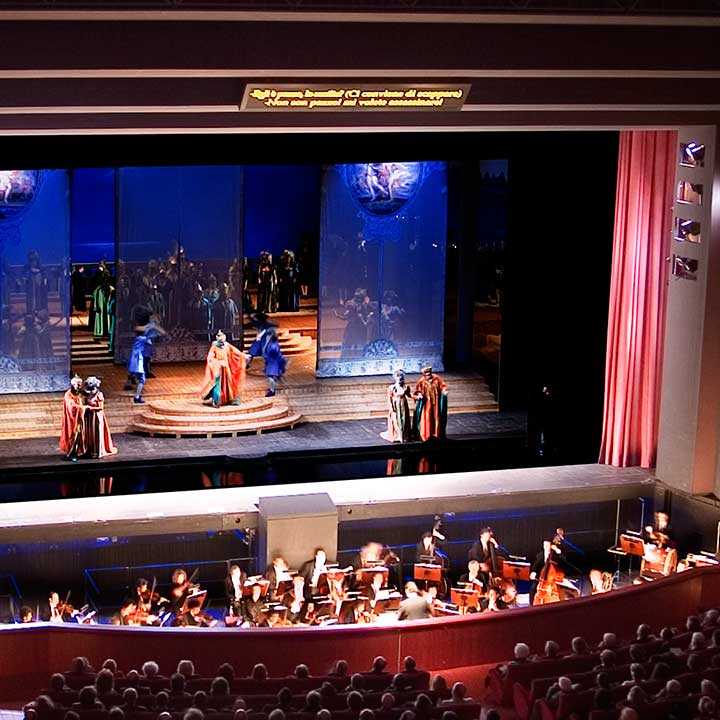 Yes, always. Unlike the cinema, operas are (almost) always presented in their original language. Therefore, if operas in German or French discourage you or you think that also in Italian you don’t understand everything, don’t worry: the operas always have double subtitles (located above the proscenium), in Italian and original language or in Italian and English (you’ll find the information on the page of each opera). You’ll have to find another excuse that isn’t the language barrier to deprive yourself of the opera…
Yes, always. Unlike the cinema, operas are (almost) always presented in their original language. Therefore, if operas in German or French discourage you or you think that also in Italian you don’t understand everything, don’t worry: the operas always have double subtitles (located above the proscenium), in Italian and original language or in Italian and English (you’ll find the information on the page of each opera). You’ll have to find another excuse that isn’t the language barrier to deprive yourself of the opera…
Duration and intermissions
Almost all the operas have at least one intermission: the interpreters catch their breath, the orchestra conductor unwinds… and you can stretch your legs, have a chat and perhaps allow yourself a drink. Information about the number and duration of the intermissions (there is often more than one), along with the length of the show, can be found on the pages of the individual operas (updated with precision soon before the opening night).
First time at the opera?
Contrary to what people often think, opera is meant for everybody: office workers, professionals, pensioners, students and teachers… The audience is only one, but it comes from all over, driven by the curiosity for a world where you speak, dream, love (and die…), always singing!
How should I dress?
Nobody will prevent you from dressing up for the opera, but the era when tails or a long dress were the rule is long over. Jeans, a top and trainers are welcome, just like a tuxedo and sequins… What’s important is that you feel at ease with yourself: therefore, feel free.
What time should I arrive?
 On time, obviously. Performances begin exactly at the time indicated on your ticket. We suggest arriving half an hour before the start (the Theatre opens 45 minutes before): this is the best way to avoid arriving stressed and overheated, in short, not in the best conditions to enjoy the show. Take your time, also because once the show begins you can enter the hall only during the intermissions and, even if there are areas with televisions in the foyer where you can see the show, it would be a real shame not to be able to watch it live!
On time, obviously. Performances begin exactly at the time indicated on your ticket. We suggest arriving half an hour before the start (the Theatre opens 45 minutes before): this is the best way to avoid arriving stressed and overheated, in short, not in the best conditions to enjoy the show. Take your time, also because once the show begins you can enter the hall only during the intermissions and, even if there are areas with televisions in the foyer where you can see the show, it would be a real shame not to be able to watch it live!
Do the operas have subtitles?
 Yes, always. Unlike the cinema, operas are (almost) always presented in their original language. Therefore, if operas in German or French discourage you or you think that also in Italian you don’t understand everything, don’t worry: the operas always have double subtitles (located above the proscenium), in Italian and original language or in Italian and English (you’ll find the information on the page of each opera). You’ll have to find another excuse that isn’t the language barrier to deprive yourself of the opera…
Yes, always. Unlike the cinema, operas are (almost) always presented in their original language. Therefore, if operas in German or French discourage you or you think that also in Italian you don’t understand everything, don’t worry: the operas always have double subtitles (located above the proscenium), in Italian and original language or in Italian and English (you’ll find the information on the page of each opera). You’ll have to find another excuse that isn’t the language barrier to deprive yourself of the opera…
Duration and intermissions
Almost all the operas have at least one intermission: the interpreters catch their breath, the orchestra conductor unwinds… and you can stretch your legs, have a chat and perhaps allow yourself a drink. Information about the number and duration of the intermissions (there is often more than one), along with the length of the show, can be found on the pages of the individual operas (updated with precision soon before the opening night).
How to arrive
By plane
From the International Airport of Torino (TRN) you can reach the city centre:
- by taxi
- by shuttle bus
- by train
- by rental car
By train
From both of the Torino train stations, Porta Susa and Porta Nuova, the Theatre can be reached by taxi (10 minutes) or on foot (about 20 minutes).
You can find your train to Torino at these internet sites:
- Trenitalia
- NTV-Italo
- GTT-SFM
- SNCF-TGV
By car
Depending on where you’re coming from, these are the main routes:
-
From the north and north-east
Motorway A4 Torino-Milano-Trieste or Motorway A5 Torino-Aosta, in both cases the exit is Corso Giulio Cesare -
From the west
Motorway A32 Torino-Bardonecchia, exit Corso Regina Margherita -
From the south and south-east
Motorway A6 Torino-Savona or Motorway A21 Torino-Brescia, exit Corso Unità d’Italia
Parking in the city center is by payment, both in the street and in the numerous underground car parks located near the Theatre:
- Roma/San Carlo/Castello
- Santo Stefano
- Vittorio Veneto
- Valdo Fusi
Please note that in Torino there is a Limited Traffic Zone (ZTL) that prohibits access to the city centre from 7.30 a.m. to 10.30 a.m. from Monday to Friday; some other streets are reserved for public transportation from 7 a.m. to 8 p.m. If you are staying in a hotel situated within the ZTL, the hotel can provide you with a pass to enter with your car.
Public transportation
The stops nearest to the Teatro Regio are:
- Castello: lines 13, 15, 55, 56
- Garibaldi: lines 4, 11, 27, 51, 57, Star2
The nearest stops of the Metro are at the train stations of Porta Nuova and Porta Susa (XVIII Dicembre).
- Porta Nuova
- Porta Susa (XVIII Dicembre)
Taxi
In Torino you can call for a taxi at the following numbers: +390115737 and +390115730; however, in Piazza Castello there are two taxi ranks.
Your experience at the Theatre
Bar and refreshment service
Before the performances and during intermissions two bars are open to the public on the second level of the foyer: you can enjoy excellent food preparations for a snack, drinks and espresso coffee.
You can also dine during the intermission, in a special area: in this case, before the performance, purchase you “Opera Buffet”.
Cloakroom
 When you go to see a show you never know what to do with your jacket, your coat, your bag, and sometimes, your umbrella. Especially when it’s time to applaud! Fortunately, for both the performances in the main hall and those at the Piccolo Regio, a free cloakroom service is available.
When you go to see a show you never know what to do with your jacket, your coat, your bag, and sometimes, your umbrella. Especially when it’s time to applaud! Fortunately, for both the performances in the main hall and those at the Piccolo Regio, a free cloakroom service is available.
Publications
 To know everything about the show you’re about to watch, pick up a monograph volume: here you’ll find presentation texts, interviews, detailed synopses and the complete libretto of the opera accompanied by numerous illustrations. You’ll receive a free copy of the leaflet with all the names of the interpreters for that show (also for sale separately). They will serve as mementos of an unforgettable evening.
To know everything about the show you’re about to watch, pick up a monograph volume: here you’ll find presentation texts, interviews, detailed synopses and the complete libretto of the opera accompanied by numerous illustrations. You’ll receive a free copy of the leaflet with all the names of the interpreters for that show (also for sale separately). They will serve as mementos of an unforgettable evening.

Реконструкция и актуальность театра
После пожара был объявлен национальный конкурс на поиск архитектора. Однако из-за войны и общего финансового положения первый камень был заложен 25 сентября 1963 года. Тем не менее, работы начались только в сентябре 1967 года под руководством архитектора Карло Моллино .
Реконструированный театр с его удивительным современным интерьером, но скрытым за первоначальным фасадом, был открыт 10 апреля 1973 года постановкой оперы Верди I vespri siciliani в постановке Марии Каллас (ее единственная неудачная попытка в этой дисциплине) и Джузеппе ДиСтефано .
Новый театр вмещает 1750 человек и имеет эллиптическую форму с большим оркестровым уровнем и 37 ложами по периметру. Для улучшения звука была добавлена акустическая оболочка.
Театр представляет широкий спектр опер в течение своих сезонов, в том числе современные произведения, хотя в первые годы нового века финансовое давление сделало расписание несколько более консервативным и отдавало предпочтение большему количеству опер 19-го века .
Ваш опыт в театре
Услуги: Бар и ресторан
Перед спектаклями и во время антрактов для публики открыты два бара на втором этаже фойе, где можно вкусно перекусить, сопровождая это выбором вина, или просто выпить чашечку кофе или безалкогольного напитка.
Вы также можете поужинать во время антракта в специально отведенном месте. В этом случае перед спектаклем купите в баре Dinner Box, в который входит ужин для гурманов с первым и вторым блюдами, гарниром, бокалом вина (или другого напитка), десерт и кофе. Dinner Box имеет фиксированную стоимость 18 евро. Услуга гарантируется во время вечерних представлений театрального сезона, которые предусматривают как минимум один антракт.
Гардероб
 Когда идешь на спектакль, никогда не знаешь, что делать с курткой, пальто, сумкой, а иногда и зонтиком. Особенно во время аплодисментов! К счастью, в распоряжении гостей предоставляется бесплатный гардероб как для спектаклей в большом зале, так и для спектаклей в театре Пикколо Реджио.
Когда идешь на спектакль, никогда не знаешь, что делать с курткой, пальто, сумкой, а иногда и зонтиком. Особенно во время аплодисментов! К счастью, в распоряжении гостей предоставляется бесплатный гардероб как для спектаклей в большом зале, так и для спектаклей в театре Пикколо Реджио.
Публикации
 Чтобы узнать все о спектакле, который вы собираетесь посетить, не забудьте о буклете. В нем вы можете найти презентационные тексты, интервью, подробные описания и полное либретто спектакля со многими фотографиями! К тому же вы получите бесплатно схему зала, список всех исполнителей спектакля (также можно приобрести отдельно). Все это будет напоминать вам о незабываемом вечере.
Чтобы узнать все о спектакле, который вы собираетесь посетить, не забудьте о буклете. В нем вы можете найти презентационные тексты, интервью, подробные описания и полное либретто спектакля со многими фотографиями! К тому же вы получите бесплатно схему зала, список всех исполнителей спектакля (также можно приобрести отдельно). Все это будет напоминать вам о незабываемом вечере.

Teatro Regio di Torino
Город
Турин
Год основания
1740
Тип
театры и залы
Театр Реджо («Королевский театр») — оперный театр в Турине. Один из старейших и самых престижных театров Италии. Построен в 1740 году, был уничтожен пожаром в 1936 и восстановлен в 1973 году. Театральный сезон длится с октября по июнь с постановкой 8-9 опер и от 5 до 12 представлений каждой из них.
До середины 18-го века в Турине не было как такового специализированного оперного театра, оперные спектали проводились в различных других театрах или на открытых площадках. В 1713 году герцог Витторио Амедео II Савойский поручил известному архитектору Филиппо Ювара спроектировать и построить новый большой оперный театр, как часть общих преобразований исторического центра Турина. Однако его намерение исполнилось только в 1738 году когда новый герцог Карло Эмануэле III Савойский решил поручить осуществление этого проекта архитектору Бенедетто Альфьери, с требованием разработать очень престижный театр. Театр Реджо в Турине был построен в рекордно короткий срок в два года и открыт 26 декабря 1740. Это был роскошный зал в пять ярусов с общим количеством мест — 2500. Ежегодно к открытию сезона специально для театра сочинялись две оперы-серия.
С 1792 по 1798 театр был закрыт. После повторного открытия в 1798 во время Наполеоновских войн и французской окупацией Турина, театр был переименован в «Национальный театр», затем в «Большой театр Искусств» и в 1804 в «Императорский театр». Репертуар театра подвергся изменению и был адаптирован под французские вкусы. Император Наполеон три раза посещал его. В 1814 году театр вернулся во владение герцогов Савойских и вернул себе старое название — «Королевский театр». В 1870 году он стал муниципальным театром. И хотя Турин не мог поспорить оперной славой с Миланом, Венецией или Римом, тем не менее в театре работали многие известные композиторы.
В 1895-1898 годах главным дирижером театра был Артуро Тосканини, при его руководстве прошло несколько итальянских премьер Рихарда Вагнера. В 1905 году театр был реконструирован, убраны 4 и 5 ярусы, расширен амфитеатор. Помимо Тосканини и Вагнера в театре работали и другие великие композиторы — Джакомо Пуччини и Рихард Штраус провели несколько премьер своих опер в театре Реджо. Во время Первой мировой войны театр был закрыт несколько лет и открылся в 1919. В ночь на 8 и 9 февраля 1936 года весь театр, кроме фасада, был разрушен сильным пожаром, и ушло почти сорок лет на его восстановление.
После пожара объявлялось несколько конкурсов на восстановление театра Реджо. В 1965 году городская администрация доверила работу архитекторам Карло Моллино и Марчелло Завелани Росси. Работы начались в начале сентября 1967 года и были завершены в начале 1973 года. Новый театр Реджо с потрясающим современным дизайном интерьера, скрытым за историческим фасадом, был открыт 10 апреля 1973 года. Новый зал имеет 1750 мест.
Театр является центром художественной и культурной жизни Турина.
Our history, in a nutshell
The Teatro Regio di Torino is one of the oldest opera theatres in existence today: its origins date back to 1740, the year in which it opened as a magnificent venue of the Savoy Court. Designed by architect Benedetto Alfieri with innovative criteria, it soon became a destination of the grand tours of the period. After almost two centuries of uninterrupted activity, the old building, a theatre “all’italiana” with five tiers of boxes, was destroyed in a violent fire on the night between 8 and 9 February, 1936.
The fire did not interrupt the programming of the Regio, which continued in other theatres across the city until the opening of the present structure. Unique in all the world for its design, thanks to the genius of architect Carlo Mollino, it was inaugurated in 1973 with I Vespri siciliani by Verdi, in the one and only stage direction of Maria Callas and Giuseppe Di Stefano.
Accessibility for all
Access to the Teatro Regio for wheelchair users is facilitated by a clearly marked route without obstacles. In the main hall there are spaces for 6 wheelchairs, which can be reached by lifts at the level of row 28. For any necessary assistance, please speak to the Theatre personnel.
Access to the Piccolo Regio Puccini is by way of a lift; to use it, it is necessary to speak directly to the Theatre personnel. In the hall there are spaces for the positioning of 2 wheelchairs.
External and internal passageways are marked with conventional symbols. In front of the Theatre there are also parking places for vehicles displaying a parking card for the disabled.
One Theatre, many proposals
The Teatro Regio offers a rich Opera and Ballet Season consisting of numerous operas, ballets and musicals. Together with the main Season there are also many other activities: symphonic-choral and chamber music concerts involving the Orchestra, Chorus and Children’s Chorus of the Teatro Regio; a series of shows staged at the Piccolo Regio Puccini and intended for schools and families; lectures, guided tours, exhibitions and special events realized in collaboration with the City of Torino and other institutions like MITO SettembreMusica. All events that put Teatro Regio at the centre of the cultural and artistic life of Torino, Piemonte and more.
Our history, in a nutshell
The Teatro Regio di Torino is one of the oldest opera theatres in existence today: its origins date back to 1740, the year in which it opened as a magnificent venue of the Savoy Court. Designed by architect Benedetto Alfieri with innovative criteria, it soon became a destination of the grand tours of the period. After almost two centuries of uninterrupted activity, the old building, a theatre “all’italiana” with five tiers of boxes, was destroyed in a violent fire on the night between 8 and 9 February, 1936.
The fire did not interrupt the programming of the Regio, which continued in other theatres across the city until the opening of the present structure. Unique in all the world for its design, thanks to the genius of architect Carlo Mollino, it was inaugurated in 1973 with I Vespri siciliani by Verdi, in the one and only stage direction of Maria Callas and Giuseppe Di Stefano.
Доступность для всех
Доступ в Театр Реджио для лиц с ограниченными возможностями на колясках облегчен благодаря обозначенному и беспрепятственному пути. В зале есть места для 6 инвалидных кресел, к которым можно подняться на лифте на высоту 28-го ряда. По всем вопросам, связанным с оказанием помощи, необходимо обращаться к сотрудникам театра.
В зал Театр Пикколо Реджио Пуччини можно попасть на лифте, для использования которого необходимо напрямую связаться с персоналом театра. В зале есть места для размещения 2 инвалидных колясок.
Внешние и внутренние переходы указаны обычными обозначениями. Напротив театра есть места для автомобилей с опознавательным знаком.
How to arrive
By plane
From the International Airport of Torino (TRN) you can reach the city centre:
- by taxi
- by shuttle bus
- by train
- by rental car
By train
From both of the Torino train stations, Porta Susa and Porta Nuova, the Theatre can be reached by taxi (10 minutes) or on foot (about 20 minutes).
You can find your train to Torino at these internet sites:
- Trenitalia
- NTV-Italo
- GTT-SFM
- SNCF-TGV
By car
Depending on where you’re coming from, these are the main routes:
-
From the north and north-east
Motorway A4 Torino-Milano-Trieste or Motorway A5 Torino-Aosta, in both cases the exit is Corso Giulio Cesare -
From the west
Motorway A32 Torino-Bardonecchia, exit Corso Regina Margherita -
From the south and south-east
Motorway A6 Torino-Savona or Motorway A21 Torino-Brescia, exit Corso Unità d’Italia
Parking in the city center is by payment, both in the street and in the numerous underground car parks located near the Theatre:
- Roma/San Carlo/Castello
- Santo Stefano
- Vittorio Veneto
- Valdo Fusi
Please note that in Torino there is a Limited Traffic Zone (ZTL) that prohibits access to the city centre from 7.30 a.m. to 10.30 a.m. from Monday to Friday; some other streets are reserved for public transportation from 7 a.m. to 8 p.m. If you are staying in a hotel situated within the ZTL, the hotel can provide you with a pass to enter with your car.
Public transportation
The stops nearest to the Teatro Regio are:
- Castello: lines 13, 15, 55, 56
- Garibaldi: lines 4, 11, 27, 51, 57, Star2
The nearest stops of the Metro are at the train stations of Porta Nuova and Porta Susa (XVIII Dicembre).
- Porta Nuova
- Porta Susa (XVIII Dicembre)
Taxi
In Torino you can call for a taxi at the following numbers: +390115737 and +390115730; however, in Piazza Castello there are two taxi ranks.
Впервые в опере?
Вопреки тому, о чем часто думают, опера предназначена всем и для всех возрастов: публика только одна, хотя она приходит отовсюду, движимая любопытством к миру, в котором говорят, мечтают, любят (и умирают…) всегда в форме пения!
Как мне одеться?
Конечно, приятно иметь возможность показать нарядную одежду в опере, но эпоха, когда фрак и длинное платье были обязательными, давно прошла. Джинсы, футболки и кроссовки приветствуются, а также смокинг и блестки… Главное – находиться в гармонии с самим собой, поэтому чувствуйте себя свободно.
Во сколько лучше прибыть?
 Конечно, вовремя. Спектакли начинаются точно в указанное на билете время. Мы рекомендуем вам прибыть раньше за полчаса (театр открывается за 45 минут до начала спектакля). Это лучший способ избежать стресса или не раскраснеться. Короче говоря, в таком возбужденном состоянии вам будет сложно насладиться спектаклем. Рассчитайте свое время, хотя бы потому, что если спектакль уже начался, вы сможете попасть в зал только во время антракта и, хотя в фойе есть залы отдыха с телевизором, где вы можете увидеть спектакль, будет очень жаль, если вы не сможете посмотреть его вживую!
Конечно, вовремя. Спектакли начинаются точно в указанное на билете время. Мы рекомендуем вам прибыть раньше за полчаса (театр открывается за 45 минут до начала спектакля). Это лучший способ избежать стресса или не раскраснеться. Короче говоря, в таком возбужденном состоянии вам будет сложно насладиться спектаклем. Рассчитайте свое время, хотя бы потому, что если спектакль уже начался, вы сможете попасть в зал только во время антракта и, хотя в фойе есть залы отдыха с телевизором, где вы можете увидеть спектакль, будет очень жаль, если вы не сможете посмотреть его вживую!
Идет ли опера с субтитрами?
 Да, всегда. В отличие от кино, оперные спектакли представлены (почти) всегда на языке оригинала. Поэтому, если произведения на немецком или французском языках вас приводят в уныние или вы думаете, что даже на итальянском языке вы не поймете всего, будьте спокойны: у оперы всегда есть двойные титры (размещенные над авансценой) на итальянском и языке оригинала или на итальянском и английском языках (найдите информацию на странице каждой оперы). Вам придется искать другое оправдание, не связанное с языковым барьером, из-за которого вы не ходите на оперу…
Да, всегда. В отличие от кино, оперные спектакли представлены (почти) всегда на языке оригинала. Поэтому, если произведения на немецком или французском языках вас приводят в уныние или вы думаете, что даже на итальянском языке вы не поймете всего, будьте спокойны: у оперы всегда есть двойные титры (размещенные над авансценой) на итальянском и языке оригинала или на итальянском и английском языках (найдите информацию на странице каждой оперы). Вам придется искать другое оправдание, не связанное с языковым барьером, из-за которого вы не ходите на оперу…
Продолжительность и антракты
Почти во всех операх и концертах есть хотя бы один антракт: исполнители переводят дыхание, дирижер вытирает пот … и вы можете размять ноги, поболтать и, возможно, что-нибудь выпить. Количество и продолжительность антрактовов (часто их больше одного), а также время спектакля вы найдете на страницах каждой отдельной оперы (естественно, накануне премьер опер информация обновляется).
Accessibility for all
Access to the Teatro Regio for wheelchair users is facilitated by a clearly marked route without obstacles. In the main hall there are spaces for 6 wheelchairs, which can be reached by lifts at the level of row 28. For any necessary assistance, please speak to the Theatre personnel.
Access to the Piccolo Regio Puccini is by way of a lift; to use it, it is necessary to speak directly to the Theatre personnel. In the hall there are spaces for the positioning of 2 wheelchairs.
External and internal passageways are marked with conventional symbols. In front of the Theatre there are also parking places for vehicles displaying a parking card for the disabled.
Как добраться
На самолете
Из международного аэропорта Турина (TRN) вы можете добраться до центра города:
- на такси
- с трансфером на автобусе
- на поезде
- взяв напрокат автомобиль
На поезде
Из обоих железнодорожных вокзалов Турина, Порта Суза и Порта Нуова, до театра можно добраться на такси (10 минут) или пешком (около 20 минут).
Вы можете найти свой поезд в Турин по этим адресам:
- Trenitalia
- NTV-Italo
- GTT-SFM
- SNCF-TGV
На машине
В зависимости от места, откуда вы едете, мы предлагаем вам основные маршруты:
-
с севера и северо-востока
Автострада A4 Torino-Milano-Trieste или Автострада A5 Torino-Aosta, в обоих случаях выезд на Corso Giulio Cesare -
с запада
Автострада Frejus A32 Torino-Bardonecchia, выезд на Corso Regina Margherita -
с юга и юго-востока
Автострада A6 Torino-Savona или Автострада A21 Torino-Brescia, выезд на Corso Unità d’Italia
За парковку в центре города взимается плата как на улице, так и на различных подземных автостоянках, расположенных рядом с театром:
- Рома/Сан-Карло/Кастелло
- Санто-Стефано
- Витторио-Венето
- Вальдо Фузи
В центральной части Турина есть Зона ограниченного движения (ZTL), въезд в которую запрещен с 7.30 до 10.30 с понедельника по пятницу. Некоторые дороги также зарезервированы для общественного транспорта с 7:00 до 20:00. Если вы проживаете в отеле, расположенном на территории ZTL, владелец отеля может получить разрешение на въезд на автомобиле.
Общественный транспорт
Ближайшие остановки к театру Реджио:
- Пьяцца Кастелло: линии 13, 15, 55, 56
- Гарибальди: линии 4, 11, 27, 51, 57, Star2
Ближайшие станции метро находятся на железнодорожных вокзалах Порта-Нуова и Порта-Суза (XVIII Дичембре).
- Порта-Нуова
- Порта-Суза (XVIII Дичембре)
Такси
В Турине вы можете вызвать такси по телефонам: +390115737 и +390115730; на площади Пьяцца Кастелло также есть два места стоянки такси.
One Theatre, many proposals
The Teatro Regio offers a rich Opera and Ballet Season consisting of numerous operas, ballets and musicals. Together with the main Season there are also many other activities: symphonic-choral and chamber music concerts involving the Orchestra, Chorus and Children’s Chorus of the Teatro Regio; a series of shows staged at the Piccolo Regio Puccini and intended for schools and families; lectures, guided tours, exhibitions and special events realized in collaboration with the City of Torino and other institutions like MITO SettembreMusica. All events that put Teatro Regio at the centre of the cultural and artistic life of Torino, Piemonte and more.
Один театр – много предложений
Театр Реджио предлагает богатый сезон спектаклей, куда входят многочисленные представления, включая оперы, балеты и мюзиклы. В театральный сезон проходят и многие другие мероприятия: симфонические, хоровые и камерные концерты, в которых участвуют оркестр, хор и детский хор театра Реджио; серия постановок, организованных в театре Пикколо Реджо Пуччини и предназначенных для школ и семей; конференции, экскурсии, выставки и необычные мероприятия при сотрудничестве с администрацией города Турина и другими организациями, например, проводимый в сентябре международный музыкальный фестиваль MITO SettembreMusica. Благодаря перечисленным инициативам Театр Реджио стал центром итальянской и международной культурной и художественной жизни.





























